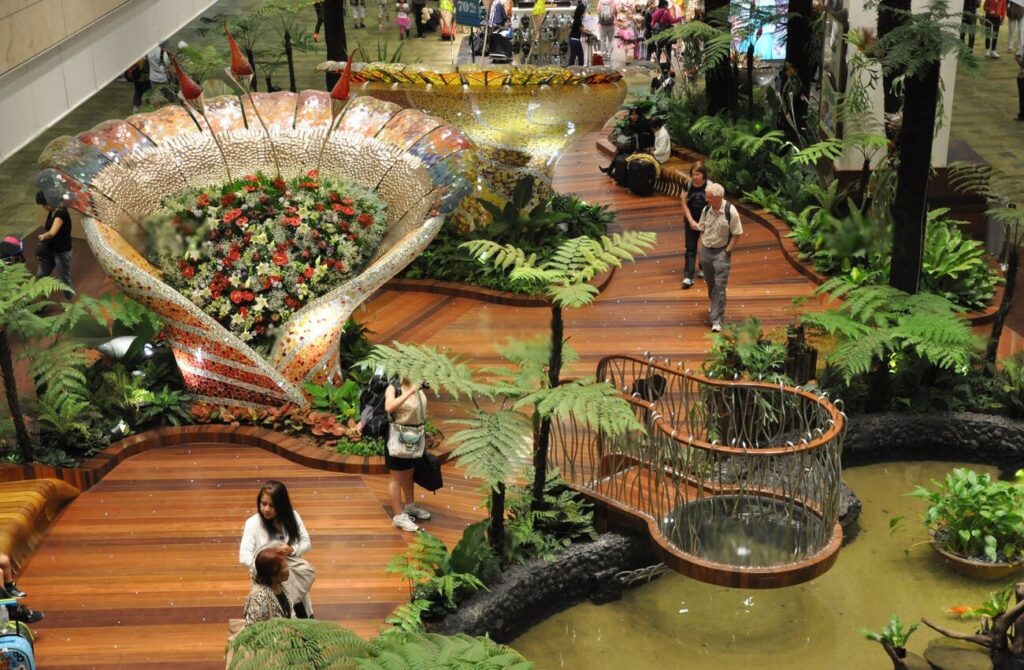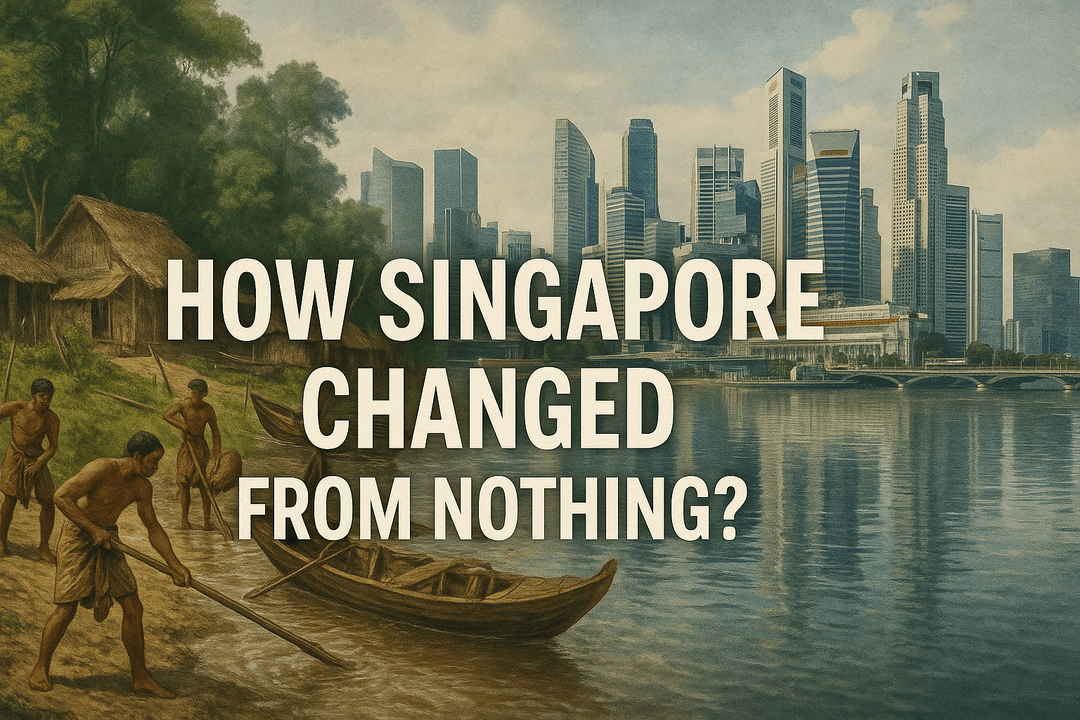History of Singapore. Singapore was once a small fishing village. Today, it is a global economic powerhouse. This tiny island nation has no natural resources. It covers only 728 square kilometers. Yet, it transformed itself through strong leadership, smart planning, and firm determination. The history of Singapore is not just about events. It is a powerful lesson in building a great nation from almost nothing.
Want to walk through this remarkable journey in real life? Gomayu offers exclusive Singapore tour packages from Nepal. Let us take care of your travel plan just pack your bags and get ready!
For now let’s know History of Singapore.
The Early Days: Pre-Colonial Singapore
Singapore became the gleaming metropolis we know today. But the history of Singapore began as a small fishing village known as Temasek. Archaeological evidence suggests human settlement dating back to the 14th century. The area was likely inhabited even earlier. The earliest written record of Singapore appear in Chinese text from the 3rd century. It refers to the island as “Pu Luo Chung” (Island at the End of the Peninsula).

The name “Singapura” (Lion City) emerged around the 13th century. According to legend, a Sumatran prince named Sang Nila Utama spotted animal. What he believed was a lion on the island. An animal that has never naturally inhabited Singapore. Despite this misnomer, the name stuck and became an part of Singapore history.
For centuries, Singapore remained a relatively unknown outpost within various Southeast Asian empires. It includes the Srivijaya Empire and the Johor Sultanate. Its strategic location at the southern tip of the Malay Peninsula. however, transform it into one of the world’s most important trading hubs.
British Colonial Era: The Foundation of Modern Singapore
The modern history of Singapore truly began on January 29, 1819. Back then Sir Stamford Raffles of the British East India Company landed on the island. Recognized its strategic potential as a trading post between China and India. Raffles negotiated with the local Malay ruler. They are Temenggong Abdul Rahman, and Sultan Hussein of Johor. And establish a British settlement.

Under British administration, Singapore was developed as a free port. It means goods could be imported and exported without duties. This policy proved transformative, attracting merchants. Mostly from across Asia, the Middle East, and Europe. The population grew rapidly as immigrants. Particularly from China, India, and the Malay Archipelago, arrived seeking economic opportunities.
The colonial era introduced significant infrastructure developments, roads, bridges, government buildings. And most importantly, port facilities. It laid the groundwork for Singapore’s future economic success. However, this period also established a deeply stratified society. Along racial and economic lines. It created tensions that would later challenge the young nation.
By early 20th century, Singapore had become Britain’s principal naval base in East Asia. And an important commercial center. The history of Singapore during this period was marked by rapid growth. But also increasing vulnerability, as demonstrated by the events of World War II.
The Dark Period: Japanese Occupation
The history of Singapore took a dark turn on February 15, 1942, when the British surrendered Singapore to Japanese forces following a brief but intense campaign. The Japanese occupation, which lasted until September 1945, represents one of the most traumatic chapters in Singapore history.

Renamed “Syonan-to” (Light of the South), Singapore under Japanese rule experienced severe hardships. Food shortages, forced labor, and a reign of terror characterized this period. The Sook Ching massacre saw thousands of Chinese Singaporeans killed in a purge. Targeting those deemed anti-Japanese.
The occupation fundamentally changed the political landscape of Singapore. It shattered the myth of British invincibility. And sparked nationalistic sentiments among the local population. When the war ended, returning to the pre-war colonial system was no longer viable. Setting the stage for Singapore’s journey toward self-governance.
Post-War Developments: The Path to Independence
The aftermath of World War II saw significant political changes in Singapore. In 1946, it became a separate crown colony, distinct from Malaya. The history of Singapore in this period was characterized by growing political consciousness. And the rise of anti-colonial movements.

In 1959, Singapore achieved self-governance within the Commonwealth. Lee Kuan Yew becoming the first Prime Minister. This marked a crucial milestone in Singapore history. As local leaders began addressing the pressing challenges. Mostly of unemployment, housing shortages, and social unrest.
Seeking economic viability and security, Singapore joined the Federation of Malaysia in 1963. However, this union proved short-lived. Ideological differences seen. Between Singapore’s People’s Action Party (PAP) and the federal government in Kuala Lumpur. Along with racial tensions. This led to Singapore’s expulsion from Malaysia on August 9, 1965.
Independence: A Nation Built from Scratch
Singapore’s independence was not celebrated but mourned by its leaders. They understood the enormous challenges ahead. With simmering ethnic tensions, the future seemed bleak. Lee Kuan Yew himself shed tears on national television. Revealing the gravity of Singapore’s predicament.
The newly independent nation faced immediate existential threats:
- Severe unemployment (around 14%)
- Housing crisis with widespread slums and squatter settlements
- Inadequate infrastructure
- Racial tensions following recent communal riots
- Security concerns as British military forces (a major employer) prepared to withdraw
- No hinterland or natural resources
From this starting point of “nothing,”. Singapore embarked on one of history’s most remarkable national transformations. Singapore from 1965 onwards visionary leadership, pragmatic policies, and social cohesion. And showed it can overcome seemingly insurmountable obstacles.
Economic Transformation: From Third World to First
The Singapore’s economic miracle began with a radical shift in development strategy. Singapore adopted an export-oriented industrialization model. The government created the Economic Development Board (EDB) to attract foreign investment. Through favorable business conditions, tax incentives, and political stability.
Initially focusing on labor-intensive manufacturing to create jobs. Singapore gradually moved up the value chain toward higher technology industries. The establishment of Jurong Industrial Estate represented a bold bet on industrialization. When many experts advocated agricultural development instead.
Singapore history shows a consistent pattern of economic reinvention. Neighboring countries began developing their own manufacturing capabilities with cheaper labor costs,. Then, Singapore pivoted to knowledge-intensive industries, financial services, and logistics. Each economic transition was carefully managed. Through educational reforms, skills development programs, and infrastructure investments.
Key economic milestones in the history of Singapore include:
- 1968: Establishment of the Development Bank of Singapore
- 1970: Opening of the first container terminal at Tanjong Pagar
- 1981: Launch of the “Second Industrial Revolution” focusing on high-tech, high-value industries
- 1985: Recovery from Singapore’s first post-independence recession through economic restructuring
- 1990s: Expansion into biomedical sciences, financial services, and digital technologies
- 2000s: Development as an innovation hub with research institutes and startups
Throughout Singapore history, pragmatism rather than ideological purity guided economic policy. The government maintained significant involvement in the economy. Through government-linked companies while embracing free market principles. This hybrid approach sometimes called “state capitalism”. It allowed Singapore to combine the efficiency of markets with long-term strategic planning.
Housing Revolution
Perhaps no aspect of Singapore’s transformation is more visible than its housing revolution. In 1960, only 9% of Singaporeans lived in public housing, mostly in poor conditions. Today, over 80% live in high-quality Housing and Development Board (HDB) apartments. Most people with approximately 90% owning their homes.
The history of Singapore’s housing policy reflects a profound understanding of social stability. The government recognized that homeownership creates a sense of belonging. And stake in the nation’s success. The HDB was established to construct affordable public housing. And implement a homeownership scheme through the Central Provident Fund (CPF). It was a mandatory savings program.

Beyond providing shelter, Singapore’s public housing policy deliberately engineered social integration. The Ethnic Integration Policy ensured each housing blockmaintained the country’s overall ethnic balance. It preventing the formation of racial enclaves. This was social engineering aspect of Singapore history. It demonstrates how physical infrastructure was used to build social cohesion.
The transformation of Singapore’s housing landscape. From slums and kampongs (villages) to modern, self-contained towns represents. It’s not just an improvement in living conditions but a reimagining of urban life. Today, Singapore’s public housing estates feature quality amenities, green spaces, and excellent connectivity. A far cry from the slums that dominated the landscape at independence.
Building a Singaporean Identity
At independence, Singapore inherited a population divided along racial, religious, and linguistic lines. Creating a unified national identity was essential for stability and development. The history of Singapore’s nation-building efforts reveals strategies. For managing diversity while fostering shared values.
The government implemented policies addressing potential fault lines:
- Language policy: While recognizing Malay, Chinese (Mandarin), Tamil, and English as official languages, English was promoted as the language of administration, business, and education providing a neutral common language
- Education system: Schools became platforms for instilling national values and creating shared experiences across ethnic groups
- National Service: Mandatory military service for all male citizens created bonds across social divides
- Multiracial meritocracy: Ensuring opportunities based on merit rather than ethnicity
- Religious harmony: Legislation and institutional arrangements to maintain peaceful coexistence among different faiths
These policies transformed Singapore history from one of racial riots. (like those in 1964) to a model of multiracial harmony. While tensions still exist beneath the surface. Singapore has largely avoided the ethnic conflicts that have plagued many diverse societies.
The carefully cultivated “Singaporean identity” emphasizes shared values. Such as meritocracy, pragmatism, and multiculturalism. National symbols, celebrations like National Day, and shared narratives about Singapore reinforce identity. The result is a society where multiple cultural traditions coexist. Within an overarching national framework.
Infrastructure and Urban Planning
Singapore’s physical transformation is perhaps the most visible aspect of its development story. From a colonial port city with unsanitary conditions and congested streets. It has become a model of urban planning. With efficient transportation, beautiful green spaces, and iconic architecture.
The history of Singapore’s urban development reveals consistent long-term planning. As early as 1971, the government created a Concept Plan projecting 40-50 years into the future. This forward-thinking approach allowed for coordinated infrastructure development. That anticipated population growth and economic needs.

Key infrastructure achievements throughout Singapore history include:
- Transportation: From the opening of the first MRT (Mass Rapid Transit) line in 1987 to today’s comprehensive network of trains, buses, and roads, Singapore created a world-class public transportation system
- Water management: Without natural aquifers, Singapore developed a “Four National Taps” strategy including water recycling (NEWater), desalination, local catchment, and imported water
- Telecommunications: Early investments in digital infrastructure positioned Singapore as one of the world’s most connected nations
- Changi Airport: Opening in 1981 and consistently ranked among the world’s best airports, it symbolizes Singapore’s global connectivity
- Port of Singapore: Developed into one of the busiest and most efficient ports globally
Perhaps most remarkably, Singapore transformed its environment from a polluted landscape. To a “City in a Garden.” Early in Singapore history, then-Prime Minister Lee Kuan Yew prioritized greening efforts. Believing that environmental quality would attract investors and improve life for citizens. The transformation from the Singapore River once biologically dead to today’s clean waterway. It exemplifies this commitment to environmental quality.
Education and Human Capital
With no natural resources, Singapore’s greatest asset has always been its people. The history of Singapore’s education system reflects a continuous effort. To develop human capital aligned with economic needs.
In the early independence years, the focus was on basic education. And technical training to support labor-intensive manufacturing. As the economy evolved, so did the education system. Emphasizing technical skills in the 1970s. Computer literacy in the 1980s. Creative thinking in the 1990s, and innovation and entrepreneurship in recent decades.
Singapore history shows a pragmatic approach to education. It adapting to changing economic requirements while maintaining high standards. The system has been criticized for being overly rigid and stressful. But reforms have attempted to balance academic excellence. with greater flexibility and holistic development.
Beyond formal education, Singapore invested heavily in workforce development through:
- Skills upgrading programs
- Continuing education incentives
- Industry-specific training institutes
- Immigration policies attracting global talent
This continuous investment in human capital has enabled Singapore to remain competitive. Despite rising costs and regional competition. The transformation from a unskilled workforce at independence to today’s educated population. It represents one of the most successful aspects of Singapore’s development.
Governance and Public Administration: The Singapore Model
The history of Singapore’s governance system reveals distinct characteristics that have become known as the “Singapore Model.” This approach features:
- Meritocratic leadership: Attracting the best talents to public service through competitive compensation and prestigious career paths
- Pragmatism over ideology: Adopting policies based on what works rather than political dogma
- Long-term planning: Looking beyond electoral cycles to future generations
- Clean government: Rigorous anti-corruption measures creating a corruption-free administration
- Rule of law: Consistent enforcement creating predictability for citizens and businesses
- Constant adaptation: Willingness to abandon policies that no longer serve their purpose
Singapore’s public administration is renowned for its efficiency and effectiveness. The Civil Service has evolved from a colonial bureaucracy to a professional organization. That drives national development. Throughout Singapore history, administrative capacity has enabled the implementation of ambitious policies. That might have failed in countries with weaker institutions.
Critics argue that Singapore’s governance model comes with significant trade-offs. In terms of political freedoms and civil liberties. The dominance of the People’s Action Party (PAP) has allowed for policy consistency. But has also limited political pluralism. Defenders counter that this stability has been essential for Singapore’s rapid development. And that the system has evolved to become more consultative over time.
International Relations
For a small nation surrounded by much larger neighbors. Foreign policy has been vital to Singapore’s survival and prosperity. The history of Singapore’s international relations demonstrates remarkable diplomatic agility.
Key principles have guided Singapore’s foreign policy:
- Maintaining sovereignty and freedom of action
- Building a regional architecture through ASEAN
- Ensuring security through defense capability and international partnerships
- Creating an international environment conducive to trade and investment
- Cultivating relationships with major powers while avoiding alignment with any single power
Singapore has punched above its weight in international affairs. It plays significant roles in organizations like ASEAN, APEC, and the United Nations. Its diplomatic influence stems from its economic success. Also strategic location, and reputation for principled pragmatism.
Throughout Singapore history, the country has navigated complex geopolitical environments
from Cold War tensions to contemporary US-China competition. Its approach has been to maintain good relations with all major powers. Also, preserving independence and avoiding being forced. To choose sides in great power conflicts.
Challenges and Criticisms
TThe history of Singapore’s development is not without controversies and criticisms. The same policies that enabled rapid development have created tensions and challenges:
- Political restrictions: Limits on press freedom, public assembly, opposition have been criticized.
- Income inequality: Despite prosperity, Singapore has relatively high income inequality. Compared to other developed nations
- Work-life balance: The culture of meritocracy and achievement has created stress on citizens.
- Aging population: Low fertility rates and increasing life expectancy create demographic challenges
- Identity questions: Younger generations question aspects of the Singapore model. And seek greater pluralism
- Regional perception: Sometimes viewed as arrogant or insular by neighboring countries
These challenges represent the complex trade-offs inherent in Singapore’s development model. The history of Singapore shows that each policy decision. While solving certain problems, created new challenges requiring further adaptation. Rade-offs inherent in Singapore’s development model. The history of Singapore shows that each policy decision, while solving certain problems, created new challenges requiring further adaptation.
Singapore Today
Modern Singapore bears little resemblance to the struggling island nation of 1965. It has one of the world’s highest GDP per capita, low crime, and high living standard. It exemplifies successful development. The history of Singapore over these decades reveals not just material progress. But the creation of a distinctive national identity and way of life.

Today, Singapore faces new challenges:
- Adapting to climate change as a low-lying island nation
- Navigating increasing regional competition
- Managing an aging population and declining birth rates
- Balancing economic growth with sustainability and inclusivity
- Maintaining social cohesion with changing demographics
- Adapting to technological disruption and the future of work
The history of Singapore teaches nation’s remarkable capacity for reinvention. The same pragmatism, long-term planning, and adaptive governance. That transformed Singapore from “nothing” continue to guide its response to contemporary challenges.
Lessons from Singapore’s Transformation
What can other developing nations learn from the history of Singapore? While specific policies may not be directly transferable due to different contexts, several principles have broader relevance:
- Leadership matters: Competent, forward-thinking leadership can overcome resource limitations
- Clean government: Controlling corruption is essential for effective development
- Pragmatism over ideology: Solutions should be judged by results rather than theoretical purity
- Invest in people: Human capital development enables economic transformation
- Think long-term: Development requires planning beyond electoral cycles
- Balance economic and social objectives: Growth without cohesion is unsustainable
- Adapt continuously: Development strategies must evolve with changing circumstances
The history of Singapore demonstrates that a country’s destiny is not determined by its size, location, or natural resources, but by the vision, determination, and adaptability of its people and leaders.
The Singapore Story Continues
The history of Singapore represents an extraordinary journey. Its transformation from a resource-poor island. To one of the world’s most advanced economies defied conventional development theories. Singapore’s development model has delivered remarkable results. In terms of material prosperity, social harmony, and national resilience.
As Singapore navigates the 21st century, it continues to reinvent itself. While maintaining the core principles that guided its development. The history of Singapore is still being written. With each generation adding new chapters. To this remarkable story of national transformation.
The tiny island nation that once had “nothing” except a strategic location. Now stands as a testament to what can be achieved through vision, and commitment. To building a better future. While Singapore’s specific path cannot be exactly replicated elsewhere. Its journey offers valuable insights for nations facing their own development challenges.
The Singapore story is not just about economic statistics or infrastructure projects. It’s about the creation of a nation and identity from diverse elements. The transformation of limitations into strengths. And the continuous effort to build a society that works for its people. In this sense, the history of Singapore represents one of humanity’s remarkable experiments. In nation-building, with lessons that continue to resonate around the world.
As Singapore celebrates its accomplishments. It also looks ahead to new challenges. Guided by the same adaptive, pragmatic approach that has defined its history. For a nation that has already transformed itself from nothing into something extraordinary. The journey of reinvention continues
We as a travel agency try to provide factful information for your better experience. If you want to travel to Singapore from Nepal after reading this beautiful history, you just have to let us know!











